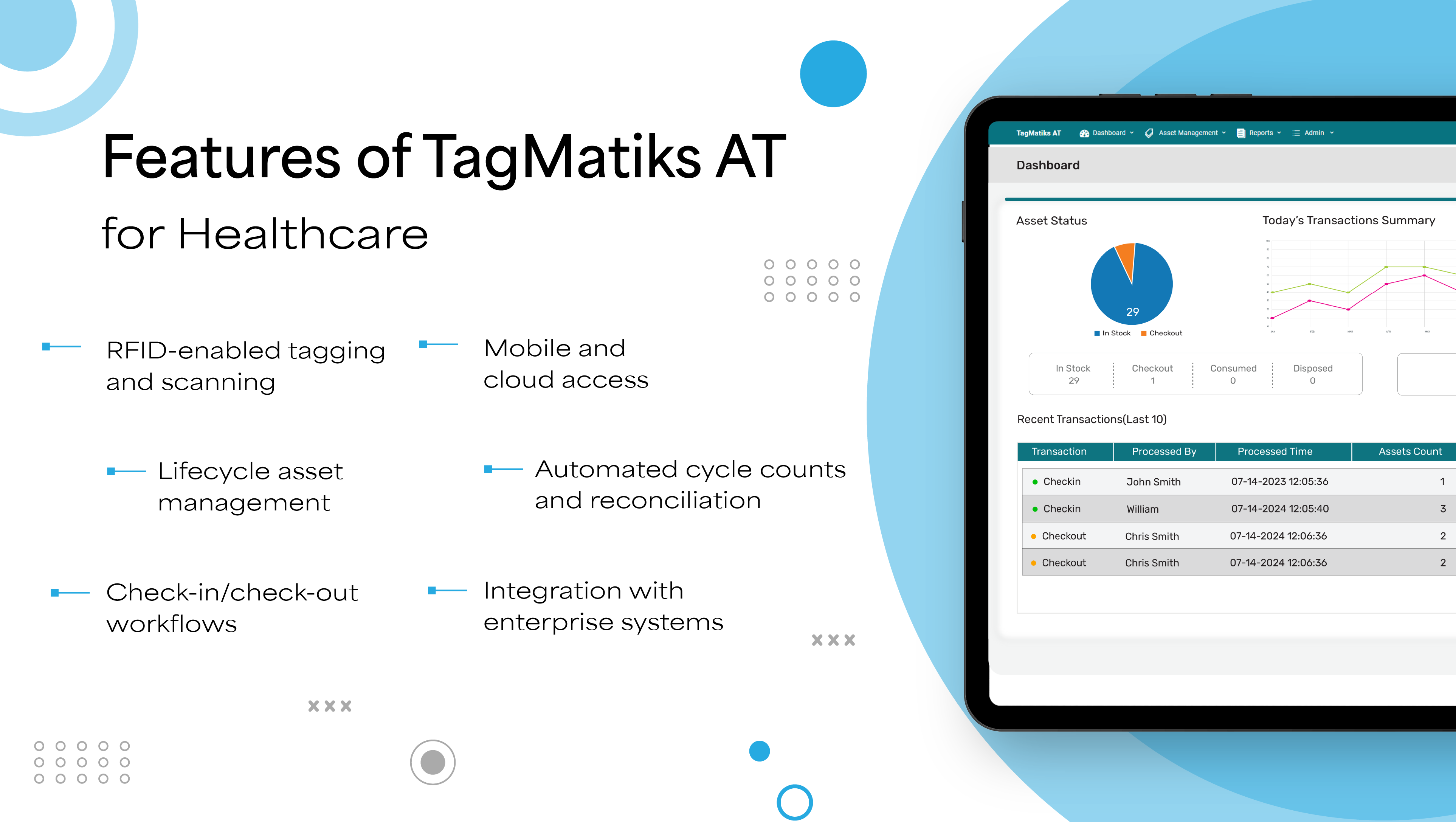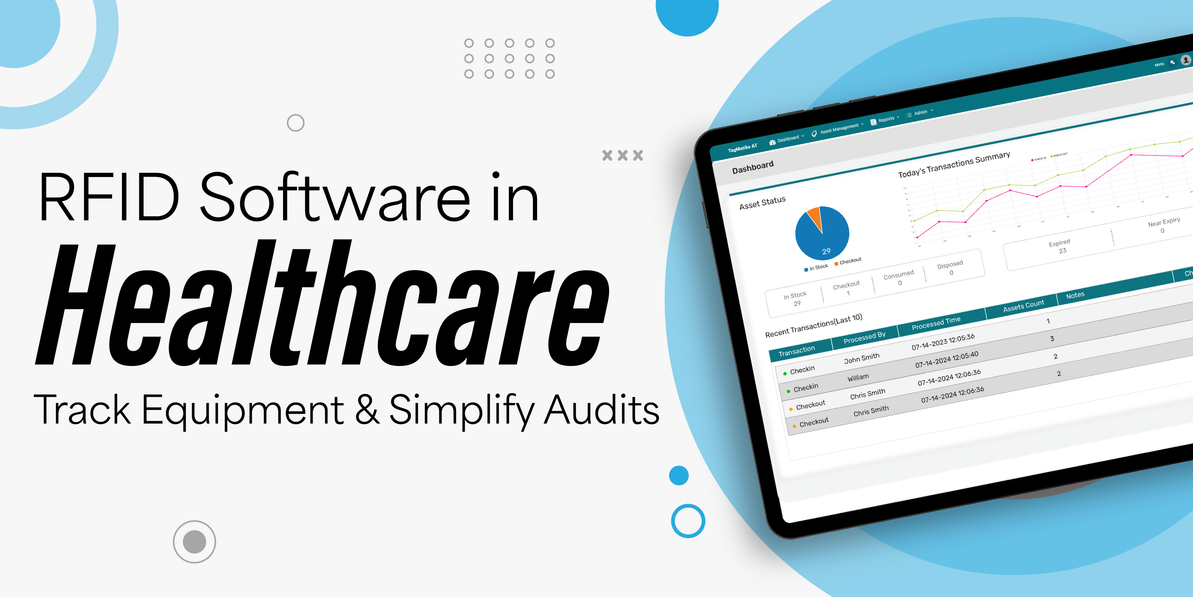RFID Software in Healthcare — Track Equipment & Simplify Audits
Introduction
RFID software is becoming essential in the healthcare industry for managing physical assets such as medical equipment, surgical instruments, and IT devices.. By combining RFID tags with intelligent tracking platforms, hospitals and clinics gain real-time visibility into asset location, usage, and condition. This automation reduces manual errors, improves operational efficiency, and simplifies audit preparation. As healthcare providers face increasing pressure to maintain compliance and control costs, RFID software offers a reliable solution for streamlining asset management and ensuring accountability.
Challenges in Healthcare Asset Management
Healthcare facilities often struggle with asset management due to outdated manual tracking methods like spreadsheets and paper logs, which are prone to errors and lack real-time visibility. High-value equipment such as infusion pumps or diagnostic tools can be misplaced, leading to unnecessary replacements. Additionally, regulatory compliance demands detailed records of asset usage and maintenance. Ensuring accountability across departments adds further pressure, especially for biomedical teams responsible for maintaining and tracking critical equipment. In addition to equipment, many hospitals face challenges in managing textiles and garments. Hospitals are using RFID to keep track of linens, reducing loss and improving hygiene compliance.
How RFID Software Solves These Problems
RFID technology addresses these pain points with precision:
- Real-time visibility: RFID readers detect tagged assets instantly, showing their location and status across facilities.
- Automated data capture: Scanning RFID tags eliminates manual entry, reducing errors and saving time.
- Workflow integration: RFID software can sync with inventory, maintenance, and procurement systems to automate tasks.
- Enhanced compliance: RFID logs provide timestamped records for audits, maintenance, and asset movement, supporting regulatory requirements.
Key Benefits of RFID Software in Healthcare
Improved asset utilization
RFID helps healthcare teams monitor how often equipment is used and where it’s located, allowing better distribution of resources and minimizing idle or underused assets.
Reduced equipment loss
Real-time tracking reduces the chances of equipment being misplaced or stolen, helping facilities avoid unnecessary replacement costs and maintain better control over high-value items.
Faster, more accurate audits
RFID systems automatically record asset movements and usage, making audits quicker and more reliable while reducing the need for manual checks and paperwork.
Time savings for staff
With RFID, staff spend less time locating equipment and more time focusing on patient care, improving overall workflow efficiency across departments.
Streamlined maintenance tracking
RFID software can schedule and log maintenance activities, helping teams stay ahead of service needs and reduce equipment downtime due to missed checks or repairs.
Data-driven decision making
Analytics from RFID platforms provide insights into asset performance and usage trends, supporting informed decisions around procurement, budgeting, and operational planning.

Featured RFID Software: TagMatiks Asset Tracking (AT)
TagMatiks AT is a cloud-based RFID asset tracking platform designed for enterprise environments, including healthcare. It supports RFID, barcode, and other AIDC technologies to streamline asset management from receipt to disposal.
Core Features:
RFID-enabled tagging and scanning
TagMatiks AT supports both handheld and fixed RFID readers, enabling fast and accurate identification of medical equipment across healthcare facilities. This reduces manual tracking errors and improves asset visibility in real time.
Mobile and cloud access
Healthcare staff can securely access asset data from mobile devices or desktops, allowing remote monitoring and faster decision-making across departments, even during audits or equipment transfers.
Lifecycle asset management
From acquisition to disposal, the software monitors each asset’s journey—including transfers, repairs, and write-offs—ensuring full traceability and accountability throughout its lifecycle.
Automated cycle counts and reconciliation
RFID-based cycle counts allow healthcare teams to quickly verify inventory and identify missing or misplaced items. Built-in reconciliation tools streamline the audit process and reduce manual effort.
Check-in/check-out workflows
TagMatiks AT automates equipment transfers and usage tracking with RFID-enabled check-in/check-out features, improving accountability and minimizing asset loss across clinical zones.
Integration with enterprise systems
The software offers APIs for seamless integration with ERP, CMMS, and other platforms, allowing healthcare providers to embed RFID tracking into existing workflows without disrupting operations.
Use Cases in Healthcare:
Tracking surgical instruments and diagnostic devices
TagMatiks AT helps healthcare teams monitor the location and usage of surgical tools and diagnostic equipment. It ensures items are available when needed and supports proper sterilization tracking, reducing delays and improving patient safety.
Managing loaner and calibration schedules
The software enables precise tracking of loaned equipment and calibration timelines. Staff can easily identify which items are borrowed, when they’re due for return, and whether they meet operational standards, helping maintain compliance and reduce downtime.
IT asset tracking
TagMatiks AT supports real-time monitoring of IT assets such as laptops, tablets, and network devices. It provides visibility across departments, helping facilities manage inventory, prevent loss, and ensure devices are properly assigned and maintained.
Linen and textile tracking
TagMatiks AT can be configured for RFID in linen tracking, helping hospitals monitor laundry cycles, reduce linen loss, and ensure timely replenishment across wards and operating rooms.
Implementation Best Practices
To maximize ROI and operational impact:
- Conduct a baseline asset audit: Identify and tag all critical assets before deployment.
- Choose appropriate RFID tags: Use tags suited for sterilization, metal surfaces, or harsh environments.
- Train staff thoroughly: Ensure users understand scanning procedures and software workflows.
- Secure data and ensure interoperability: Confirm that the RFID system complies with healthcare data standards and integrates smoothly with existing platforms.
Conclusion
RFID software is reshaping how healthcare organizations manage equipment and maintain compliance. By automating asset tracking and simplifying audit workflows, solutions like TagMatiks Asset Tracking (AT) help reduce manual errors, improve operational efficiency, and ensure regulatory readiness. From surgical instruments to IT devices, RFID provides real-time visibility and control across the asset lifecycle. For hospitals, clinics, and labs aiming to modernize their infrastructure, RFID is not just a technology upgrade—it’s a strategic investment in accountability, safety, and performance.
Recent Posts
-
RFID Portals in Manufacturing: Tracking Work-in-Progress Efficiently
Introduction Manufacturing thrives on precision and timing. Every part, component, and subassembly m …Dec 15th 2025 -
RF Shielding Explained: Types, Applications, and Benefits
Introduction RF shielding is essential for protecting devices from electromagnetic interference. Thi …Dec 8th 2025 -
How Smart Cabinets are Revolutionizing Surgical Inventory
Hospitals face constant challenges in managing surgical inventory. From stockouts that delay critica …Dec 1st 2025




